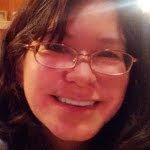
I'm pretty sure this has been done but anyway, here's my take on it. I used one Moda jelly roll. This one happens to be Plume, by Tula Pink. I needed extra fabric for the backing and binding but if you use cross-grain binding, you could easily use some of the extra strips for that. I like bias binding so I used some fabric from my stash. So anyway, here goes. All seams are a scant 1/4" and you should press seams as you go. When possible, nest seams at intersections. Oh, and please excuse the awful pictures. I took most of these in our old house which had horrible lighting and some were taken with my phone (what was I thinking?).

First separate your strips. I used the floral ones for the middles, but there weren't quite enough so I used some of my border strips for the missing middles. Make sure there are at least twenty-five border strips.
The ones on the right are extras that I didn't use on the front. They can be used as part of the backing (more on that later) or for binding.

Now take the strips for the borders. The first thing I always do is cut the selvages from the ends of the strips. Don't cut too much! Then, from each one, cut two 10.5" pieces and two 6.5" pieces. These will make up the border for one block. This will leave enough left for one "middle" for later. Repeat with twenty-four more border strips for a total of twenty-five sets. Set aside all of the extra pieces. In the picture below I already cut the extra piece.

Next you need to cut seventy-five 6.5" strips for the middles. I was able to get six from each "middle" jelly roll strip. I had nine of those so I had to cut an additional twenty-one 6.5" strips. Use the extra pieces from the border strips for this.

Separate the middles into sets of three. I put the darker/more solid strips in the center. You should have twenty-five sets.

Sew each set of three middles together as shown and press the seams.

Take your shorter border strips and sew them to the ends of the middle units as shown.

Then take the longer border strips and sew them to the sides as shown. One block done! Repeat until you have completed twenty-five blocks.

Next lay out your blocks. I turned every other block so that the middles go in alternating directions. See those two blocks on the left side of the bottom row? I turned those before I sewed the blocks together.

Sew the blocks into rows, and then sew the rows together. Your quilt top is done! If you want to, you can add a border here with some matching or contrasting fabric. I didn't want a border.
Press the quilt top well using lots of starch. I use Magic Sizing. Prepare your quilt back. I chose to make the extra pieces into a larger block by sewing them bricklayer style and then trimming. Then I sewed the backing fabric (which I got ultra-cheap at Connecting Threads in the clearance section) around the block. Scroll down for pics of the back. Press your quilt back with lots of starch too.
Sandwich and baste your quilt. I used Elmer's School Glue to baste mine. I put the batting down and smoothed it out. Then laid the backing on top, folded back about 10" at a time, and drizzled the glue in a thin zig zag pattern. Smooth down the backing fabric and press to dry the glue quickly. Repeat all the way across the back. Then I flipped the whole works over and did the same for the quilt top. You want to use a very thin drizzle of glue and remember that it doesn't need to be a solid sheet of glue. My machine has never had a problem with sewing through glue basting but your mileage may vary.
Quilt as desired, then bind your quilt. Don't forget to add a label! I chose to do this corner thing with the label but I don't like the "pocket" effect it gives so I'm going to hand sew the free edge down. I made the label on my embroidery machine.

and here's the finished quilt. Pretty!

and the back, including the block made from the scraps. Yes, it went on a little crooked. Oops.


linking to:
skip to my lou
mad in crafts
keeping it simple
creating my way to success
ladybug blessings
memories by the mile
sugar bee crafts
funky polka dot giraffe
nap time creations




































































